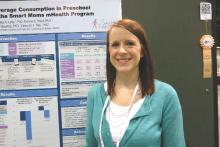LOS ANGELES – A mobile phone–based intervention targeting both maternal and child behavior significantly cut sugar-sweetened drink consumption in preschoolers and prompted modest weight loss in Moms.
After just 3 months, the children reduced their daily intake of sugar-sweetened beverages (SSB) by 10 fluid ounces, compared with 3.2 ounces for controls, while their mothers lost 2.6% of their body weight vs. a gain of 1.4% for controls.
Both outcomes were statistically significant in regression analysis, after adjusting for child age and baseline SSB intake (P = .02) and for maternal age and race (P = .003).
On the surface, 10 fluid ounces may not sound like a lot, but at study entry these 3- to 5-year-old North Carolinian preschoolers were already consuming at least 12 ounces per day of SSBs such as 100% fruit juice, fruit drinks, sweetened tea, flavored milks, sports/energy drinks, and sodas.
“Sugar-sweetened beverages really stand out as one of the drivers of excessive weight gain in early childhood and 10 ounces is a lot for kids,” study author Ms. Brooke Nezami of the University of North Carolina in Chapel Hill, said in an interview at Obesity Week 2015. “The American Academy of Pediatrics says a serving of 100 percent fruit juice is 4 to 6 ounces, so that’s over 2 servings a day.”
Targeting mothers as the agent of change to improve child dietary behaviors may help them make healthy choices and lose weight, but getting busy moms to participate has been a huge hurdle for traditional interventions.
The Smart Moms intervention sought to reduce child SSB intake to one serving per day using 12 weekly and six bi-weekly website lessons, developed based on social cognitive theory. Children’s consumption of SSBs and mothers’ caloric beverages, high-calorie “red” foods from the Traffic Light Diet, and weight were monitored daily, with totals submitted weekly via text, Ms. Nezami, of the University of North Carolina at Chapel Hill, reported.
The mothers, who had a body mass index (BMI) of 25 kg/m2 to 50 kg/m2 at enrollment, were asked to reduce their intake of caloric beverages to less than 8 ounces per day, reduce intake of “red” foods, and to weigh themselves daily. They attended only one group meeting and then received text messages three to four times per week with tips, motivational messages, and self-monitoring prompts and 12 weekly and 6 biweekly emails with personalized feedback on their progress.
The 51 mothers and 51 children, recruited from the community, also completed in-person and on-line assessments at baseline, 3 months, and 6 months. The 6-month data are to be reported at a meeting next year.
At baseline, children in the Smart Moms intervention and wait-list control groups had an average age of 4.5 years; 40.7% vs. 58.3%, respectively, were boys; 18.5% vs. 29.2% were overweight or obese; and they consumed 15.3 ounces vs. 12.5 ounces of SSBs per day.
Mothers in the intervention and control groups had an average age of 36 years; average BMI of 33.1 kg/m2 vs. 32 kg/m2, respectively; 74% vs. 65% had an annual income of more than $75,000; and 92.6% vs. 87.5% were married.
At 3 months, daily calories from beverages declined from 252 to 131.5 among women using the intervention and rose from 169.5 to 216.7 among controls, Ms. Nezami reported in the award-winning poster.
Moms using the intervention cut their total daily calories from 1,865 to 1,569 at 3 months, compared with a small increase from 1,750 to 1,805 for controls. The differences for both outcomes were not statistically significant.
Child BMI-z scores declined from 0.30 to 0.27 with the intervention and from 0.49 to 0.45 among controls, but the difference was not significant.
Adherence to the mobile intervention remained strong at 3 months, with an average of 11 of 12 weekly self-monitoring reports and 11 of 12 weekly goal progress assessments completed, Ms. Nezami said.
“This low-burden, mobile-delivered intervention has the potential for widespread dissemination and could be an effective way to change weight-related behaviors in preschool-age children and their parents,” she concluded at the meeting, presented by the Obesity Society and American Society for Metabolic and Bariatric Surgery.
That said, some mothers may need additional encouragement from health care providers to recognize that early childhood is an opportune time to promote healthy eating habits and to reduce SSB intake.
“Most moms in the study when I presented them with the information on the risk of sugar-sweetened beverages and the calories their child was consuming from beverages were like, ‘Wow, this is something I need to change,’ ” she said. “But some participants didn’t necessarily feel at the end of it all that changing their child’s diet was as important as changing their own because they feel they’re young, they’ve still got time to create healthy diets of their own.”


